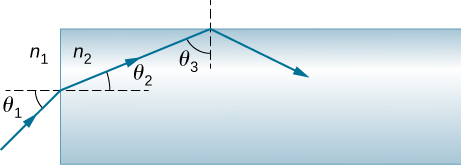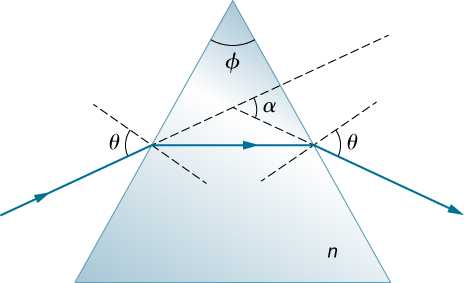| << Chapter < Page | Chapter >> Page > |
Cornu performed Fizeau’s measurement of the speed of light using a wheel of diameter 4.00 cm that contained 180 teeth. The distance from the wheel to the mirror was 22.9 km. Assuming he measured the speed of light accurately, what was the angular velocity of the wheel?
114 radian/s
Suppose you have an unknown clear substance immersed in water, and you wish to identify it by finding its index of refraction. You arrange to have a beam of light enter it at an angle of , and you observe the angle of refraction to be . What is the index of refraction of the substance and its likely identity?
Shown below is a ray of light going from air through crown glass into water, such as going into a fish tank. Calculate the amount the ray is displaced by the glass given that the incident angle is and the glass is 1.00 cm thick.

3.72 mm
Considering the previous problem, show that is the same as it would be if the second medium were not present.
At what angle is light inside crown glass completely polarized when reflected from water, as in a fish tank?
Light reflected at from a window is completely polarized. What is the window’s index of refraction and the likely substance of which it is made?
(a) Light reflected at from a gemstone in a ring is completely polarized. Can the gem be a diamond? (b) At what angle would the light be completely polarized if the gem was in water?
a. 1.92. The gem is not a diamond (it is zircon). b.
If is Brewster’s angle for light reflected from the top of an interface between two substances, and is Brewster’s angle for light reflected from below, prove that .
Unreasonable results Suppose light travels from water to another substance, with an angle of incidence of and an angle of refraction of . (a) What is the index of refraction of the other substance? (b) What is unreasonable about this result? (c) Which assumptions are unreasonable or inconsistent?
a. 0.898; b. We cannot have , since this would imply a speed greater than c . c. The refracted angle is too big relative to the angle of incidence.
Unreasonable results Light traveling from water to a gemstone strikes the surface at an angle of and has an angle of refraction of . (a) What is the speed of light in the gemstone? (b) What is unreasonable about this result? (c) Which assumptions are unreasonable or inconsistent?
If a polarizing filter reduces the intensity of polarized light to of its original value, by how much are the electric and magnetic fields reduced?
Suppose you put on two pairs of polarizing sunglasses with their axes at an angle of . How much longer will it take the light to deposit a given amount of energy in your eye compared with a single pair of sunglasses? Assume the lenses are clear except for their polarizing characteristics.
(a) On a day when the intensity of sunlight is , a circular lens 0.200 m in diameter focuses light onto water in a black beaker. Two polarizing sheets of plastic are placed in front of the lens with their axes at an angle of . Assuming the sunlight is unpolarized and the polarizers are efficient, what is the initial rate of heating of the water in , assuming it is absorbed? The aluminum beaker has a mass of 30.0 grams and contains 250 grams of water. (b) Do the polarizing filters get hot? Explain.
a. ; b. yes
Light shows staged with lasers use moving mirrors to swing beams and create colorful effects. Show that a light ray reflected from a mirror changes direction by when the mirror is rotated by an angle .
Consider sunlight entering Earth’s atmosphere at sunrise and sunset—that is, at a incident angle. Taking the boundary between nearly empty space and the atmosphere to be sudden, calculate the angle of refraction for sunlight. This lengthens the time the Sun appears to be above the horizon, both at sunrise and sunset. Now construct a problem in which you determine the angle of refraction for different models of the atmosphere, such as various layers of varying density. Your instructor may wish to guide you on the level of complexity to consider and on how the index of refraction varies with air density.
First part: . The remainder depends on the complexity of the solution the reader constructs.
A light ray entering an optical fiber surrounded by air is first refracted and then reflected as shown below. Show that if the fiber is made from crown glass, any incident ray will be totally internally reflected.

A light ray falls on the left face of a prism (see below) at the angle of incidence for which the emerging beam has an angle of refraction at the right face. Show that the index of refraction n of the glass prism is given by
where is the vertex angle of the prism and is the angle through which the beam has been deviated. If and the base angles of the prism are each what is n ?

proof; 1.33
If the apex angle in the previous problem is and , what is the value of ?
The light incident on polarizing sheet is linearly polarized at an angle of with respect to the transmission axis of . Sheet is placed so that its axis is parallel to the polarization axis of the incident light, that is, also at with respect to . (a) What fraction of the incident light passes through ? (b) What fraction of the incident light is passed by the combination? (c) By rotating , a maximum in transmitted intensity is obtained. What is the ratio of this maximum intensity to the intensity of transmitted light when is at with respect to ?
a. 0.750; b. 0.563; c. 1.33
Prove that if I is the intensity of light transmitted by two polarizing filters with axes at an angle and is the intensity when the axes are at an angle then the original intensity. ( Hint: Use the trigonometric identities and

Notification Switch
Would you like to follow the 'University physics volume 3' conversation and receive update notifications?